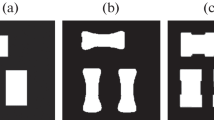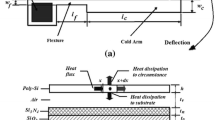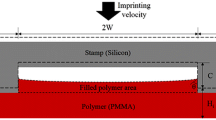Abstract
The lithography process is the most critical step in fabricating nanostructure for integrated circuit manufacturing. The most important variable in lithography process is the line width or critical dimension (CD), which perhaps is one of the most direct impact variables on the device performance and speed. This study presents a framework combining Taguchi orthogonal experiments, artificial neural network (ANN) modeling technique and genetic algorithm for sub-100 nm contact holes fabrication in lithography process. The Taguchi method utilizes S/N ratio and ANOVA to analyze the significant process parameters related to the CD, whereas the ANN establishes the relationship between controllable parameters and quality responses. The proposed Neural-Genetic approach not only can find optimal or close-to-optimal solutions but also can obtain both better and more robust results than the ANN algorithm. The confirmation results clearly demonstrated both the smaller-the-better CD and nominal-is-best CD (target 50 nm) that the proposed procedure was effective and practicable from a production perspective.
Similar content being viewed by others
References
Chang Y.P., Low C.Y. (2008) Optimization of a passive harmonic filter based on the neural-genetic algorithm with fuzzy logic for a steel manufacturing plant. Expert Systems with Applications 34: 2059–2070. doi:10.1016/j.eswa.2007.02.040
Chung J.H., Choi S.J., Kan Y., Woo S.G., Moon J.T. (2000) Novel resist material for sub-100-nm contact hole pattern. Proceedings of the Society for Photo-Instrumentation Engineers 3999: 305–312. doi:10.1117/12.388315
Edgar T.F., Butler S.W., Campbel W.J., Pfeiffer C., Bode C., Hwang S.B., Balakrishnan K.S., Hahn J. (2000) Automatic control in microelectronics manufacturing: practices, challenges, and possibilities. Automatica 36(11): 1567–1603. doi:10.1016/S0005-1098(00)00084-4
Fausett L. (1994) Fundamentals of neural networks: Architecture, algorithms, and applications. Englewood Cliffs, New Jersey, Prentice-Hall
Hien S., Czech G., Domke W., Richter E., Sebald M., Stiebert I. (1999) Thin film imaging with CARL photoresist at the optical resolution limit. Journal of Photopolymer Science and Technology 12: 673–678. doi:10.2494/photopolymer.12.673
Holland J.H. (1975) Adaptation in natural and artificial systems. University of Michigan Press, Ann Arbor, MI, USA
Hopfield J., Tank D. (1985) Neural computation of decisions in optimization problems. Biological Cybernetics 52: 141–152
International Technology Roadmap for Semiconductors (ITRS) (2003). public.itrs.net.
Ishibashi T., Toyoshima T., Yasuda N., Kanda T., Tanaka H., Kinoshita Y., Watase N., Eakin R. (2001) Advanced micro-lithography process with chemical shrink technology. Japanese Journal of Applied Physics 40(Part 1): 419–425. doi:10.1143/JJAP.40.419
Jean M.D., Lin B.T., Chou J.H. (2008) Application of an artifical neural network for simulting robust plasma-sprayed zirconia coatings. Journal of the American Ceramic Society 91(5): 1539–1547. doi:10.1111/j.1551-2916.2008.02306.x
Kailath, T., & Tay, A. (2001). Extending the life of optical lithography. Innovation, 2(3).
Khaw J.F.C., Lim B.S., Lim L.E.N. (1995) Optimal design of neural networks using Taguchi method. Neurocomputing 7: 225–245. doi:10.1016/0925-2312(94)00013-I
Kim J.S., Choi C.I., Kim M.S., Bok C.K., Kim H.S., Baik K.H. (1998) Implementation of sub-150 nm contact hole pattern by resist flow process. Japanese Journal of Applied Physics 37(Part 1): 6863–6868. doi:10.1143/JJAP.37.6863
Kuo C.F., Su T.L., Li Y.C. (2007) Construction and analysis in combining the Taguchi method and the back propagation neural network in the PEEK injection molding process. Polymer-Plastics Technology and Engineering 46(9): 841–848. doi:10.1080/03602550701278103
Lee S.J., Chen H. (1991) Design optimization with back-propagation neural networks. Journal of Intelligent Manufacturing 2: 293–303. doi:10.1007/BF01471177
Lin H.L., Chou C.P. (2008) Modeling and optimization of Nd:YAG laser micro-weld process using Taguchi Method and a neural network. International Journal of Advanced Manufacturing Technology 37: 513–522. doi:10.1007/s00170-007-0982-3
Lo Y.L., Tsao C.C. (2002) Integrated Taguchi method and the neural network analysis of physical profiling in the wirebonding process. IEEE Transactions on Computer and Package Technology 25(2): 270–277. doi:10.1109/TCAPT.2002.1010017
Lucas K., Slezak M., Ercken M., Van Roey F. (2001) 193-nm contact photoresist reflow feasibility study. Proceedings of the Society for Photo-Instrumentation Engineers 4345: 725–736. doi:10.1117/12.436850
Mok S.L., Kwong C.K. (2002) Application of artificial neural network and fuzzy logic in a case-based system for initial process parameter setting of injection molding. Journal of Intelligent Manufacturing 13(3): 165–176. doi:10.1023/A:1015730705078
NeuralWare (2002). Neuralworks professional II/Plus v.5.4, NeuralWare, Carnegie.
Quirk M., Serda J. (2001) Semiconductor manufacturing technology. Prentice Hall, NJ, USA
Renaud, J., Sellar, R., Batill, S., & Kar, P. (1994). Design driven coordination procedures for concurrent subspace optimization in MDO. In Proc of 35 AIAA/ASME structures and material conference.
Schaper, C. D., El-Awady, K., Tay, A., & Kailath, T. (1999b). Control systems for the nanolithography process. In Proceedings of the 38th IEEE Conference on Decision and Control (pp. 4173–4178). Phoenix, Arizona, USA.
Su C.T., Chiang T.L. (2002) Optimal design for a ball grid array wire bonding process using a neuro-genetic approach. IEEE Transactions on Electronics Packaging Manufacturing 25(1): 13–18. doi:10.1109/TEPM.2002.1000478
Tsai J.T., Chou J.H., Liu T.K. (2006) Tuning the structure and parameters of a neural network by using hybrid Taguchi-genetic algorithm. IEEE Transactions on Neural Networks 17(1): 69–80. doi:10.1109/TNN.2005.860885
Tsai J.T., Liu T.K., Chou J.H. (2004) Hybrid Taguchi-genetic algorithm for global numerical optimization. IEEE Transactions on Evolutionary Computation 8(4): 365–377. doi:10.1109/TEVC.2004.826895
Wong J.T., Su C.T., Hsieh H.T. (2007) A framework for determining MIMO process parameters by a neuro-DM&ACO approach. International Journal of Production Research 45(15): 3505–3520. doi:10.1080/00207540500471814
Zhang J.Z., Chen J.C., Kirby E.D. (2007) The development of an in-process surface roughness adaptive control system in turning operations. Journal of Intelligent Manufacturing 18(3): 301–311. doi:10.1007/s10845-007-0024-x
Author information
Authors and Affiliations
Corresponding author
Rights and permissions
About this article
Cite this article
Li, TS., Chen, SH. Modeling and optimization of thermal-flow lithography process using a neural-genetic approach. J Intell Manuf 22, 191–200 (2011). https://doi.org/10.1007/s10845-009-0271-0
Received:
Accepted:
Published:
Issue Date:
DOI: https://doi.org/10.1007/s10845-009-0271-0




